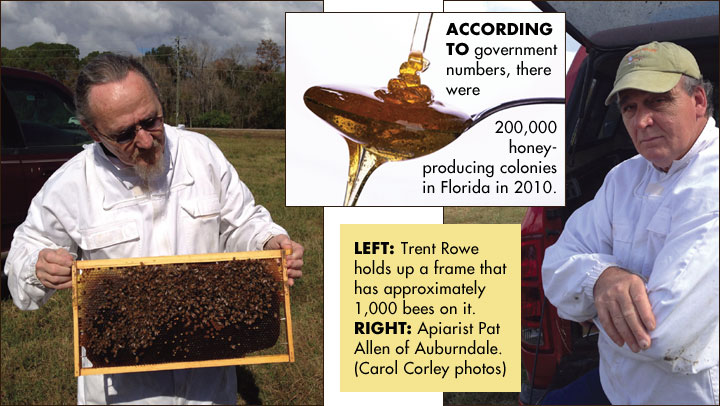When Pat Allen goes to work, he expects to be stung. But his hurt is bittersweet. He is a beekeeper who, with millions of busy bees, makes honey.
Pat, and his wife, Jan (who was brought up in our area), came south from Lake Placid, New York, a year ago to live in Auburndale. They brought three hives with them, filled with bees that were, no doubt, as glad as their human companions to get away from the cold.
After five years as apiarists, they have 30 hives in a field in Auburndale. Some of their hives are “rescues.” Pat collects bees that settle where people don’t want them … under eaves or in old barrels, for example. At one point, he rescued a colony that took up residence in an old mop bucket.
Bees keep active all year long in Central Florida, but there isn’t much for them to do in the hot summer when few plants are producing flowers for nectar and pollen. Jan feeds her bees then, letting them eat some of the honey they have stored in wax combs. Sugar is an alternative food, but it doesn’t have all the good-for-bees nutrients that they put into their honey, Pat says.
Pat starts his bees with wooden frames that hold the wax and honey they produce, giving them somewhere to start storage in bee boxes. The same frame can hold pollen, jelly (food), eggs, and honey. Jelly is made by bees eating pollen, processing it in their bodies, and regurgitating it.
The flavor of honey depends on the flowers the bees visit. Pat says this was a lean year for orange blossom because of the weather. His bees also produce holly and wildflower honey. The nectar is harvested by cutting the wax holding in the sweetness and spinning the frames in a centrifuge.
What does an apiarist do with honey? Jan says they use it in tea and coffee, both hot and iced, as well as on cereal and as an ingredient in cooking.
K.C.’s Big Dipper on Cypress Gardens Road in Winter Haven makes honey-flavored frozen custard from the Allens’ product.
Jan’s favorite recipe is for salmon or steelhead trout. Sprinkle a fillet with kosher salt and pepper. Marinate it in mojo (in the international foods section of the supermarket or a Latin store) overnight. Drain. Drizzle the fish with honey and bake it for 15 minutes at 350 degrees.
Another favorite is a honey-soy-garlic brush-on. Whisk honey into soy sauce and add garlic to taste. Brush this over fish as it cooks. Leftovers top Caesar salad.
One thing, I’ve found, you should not do with honey is put it in a frozen smoothie. It turns hard and clogs the straw something fierce, making your cheeks slam into each other. Use a spoon instead and enjoy nature’s sweetness.
CREDIT
story by TRENT ROWE
Trent Rowe the food editor of Central Florida Ag News.

